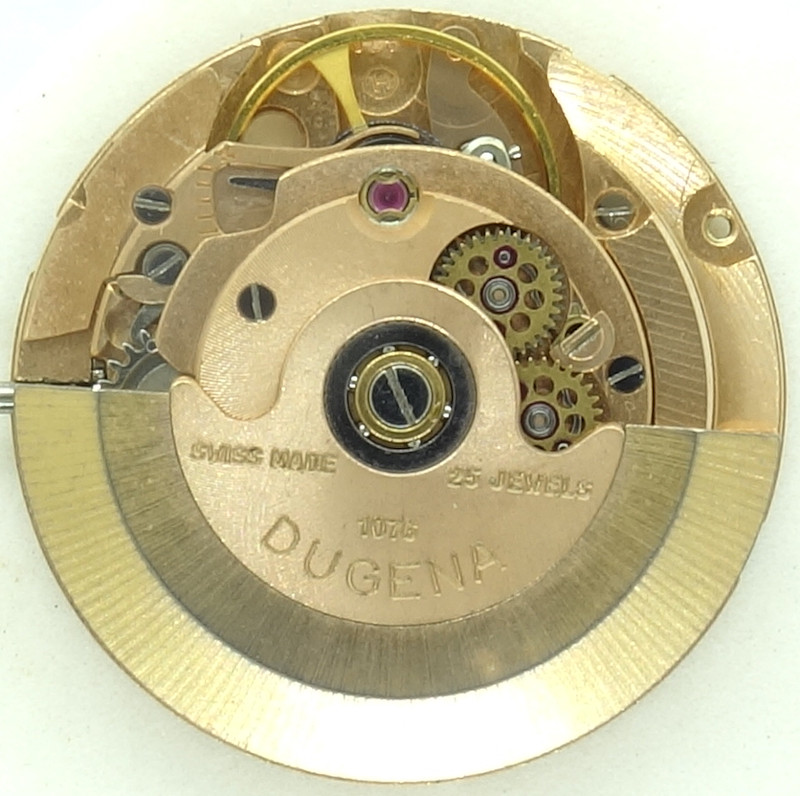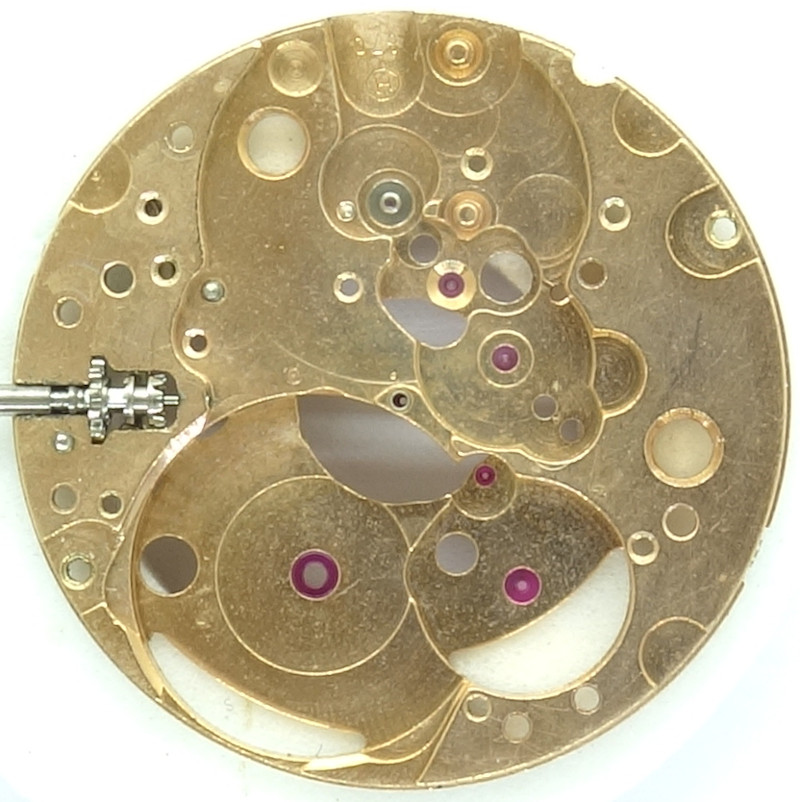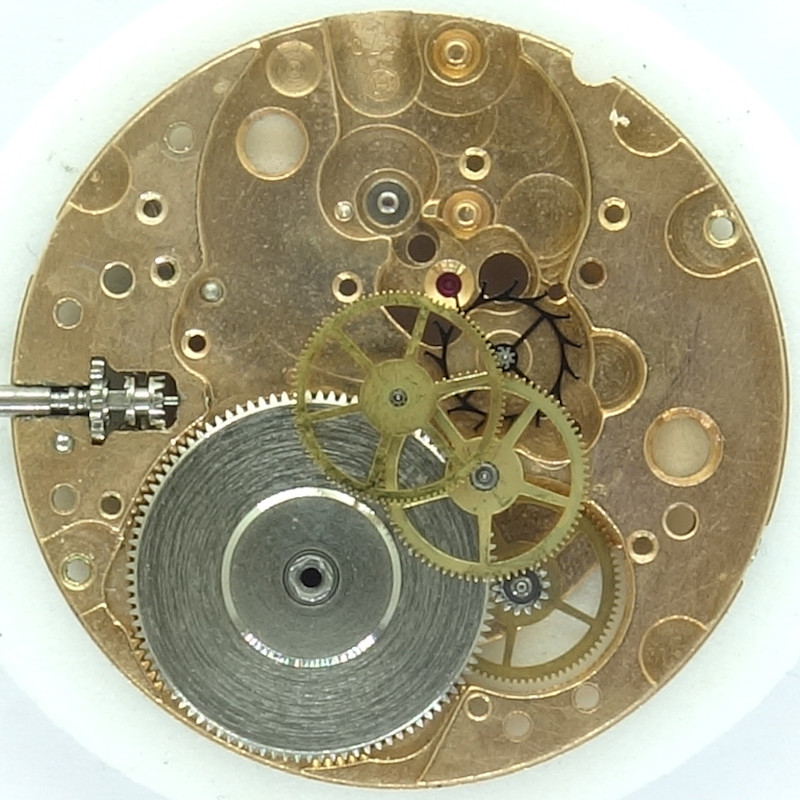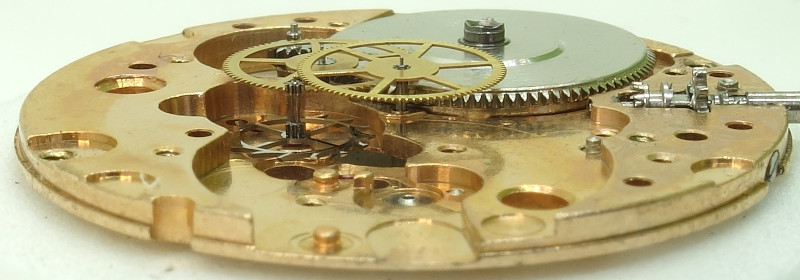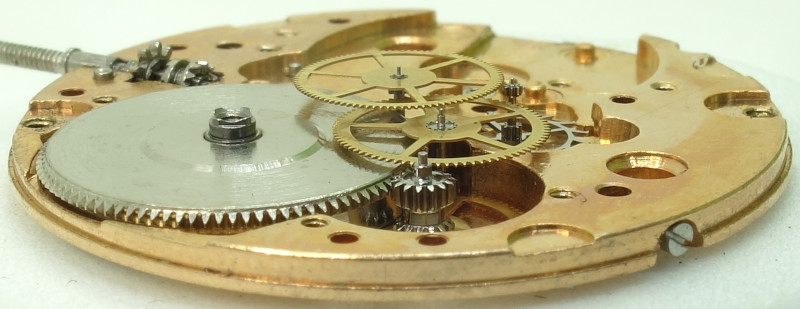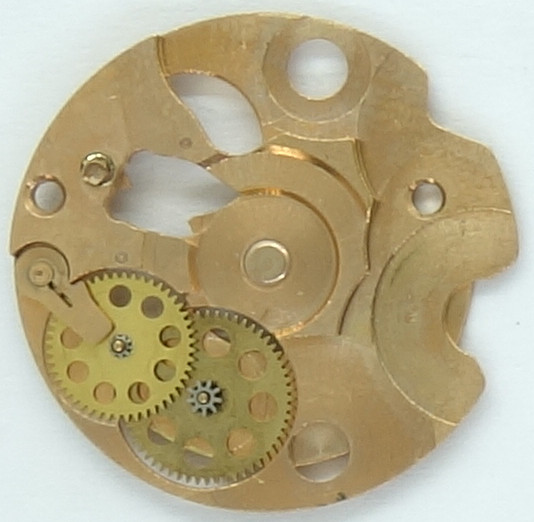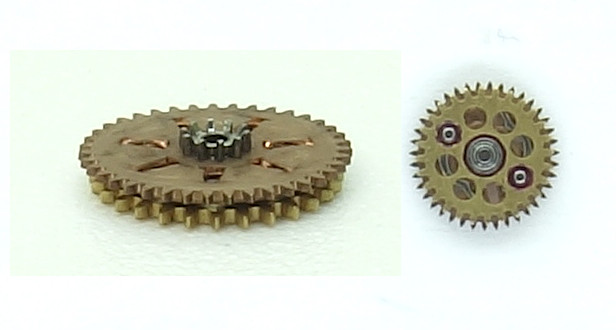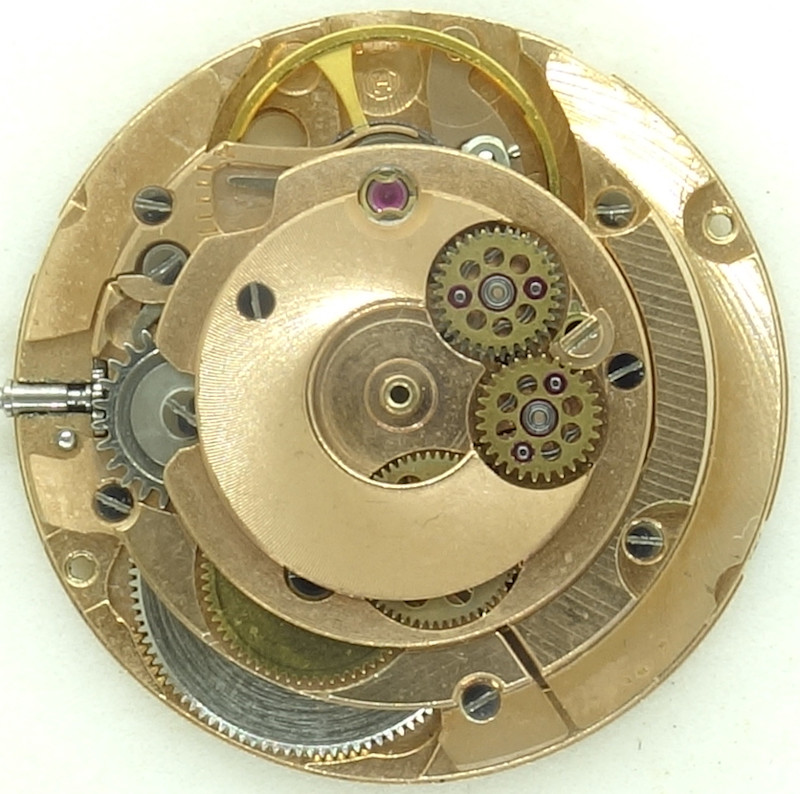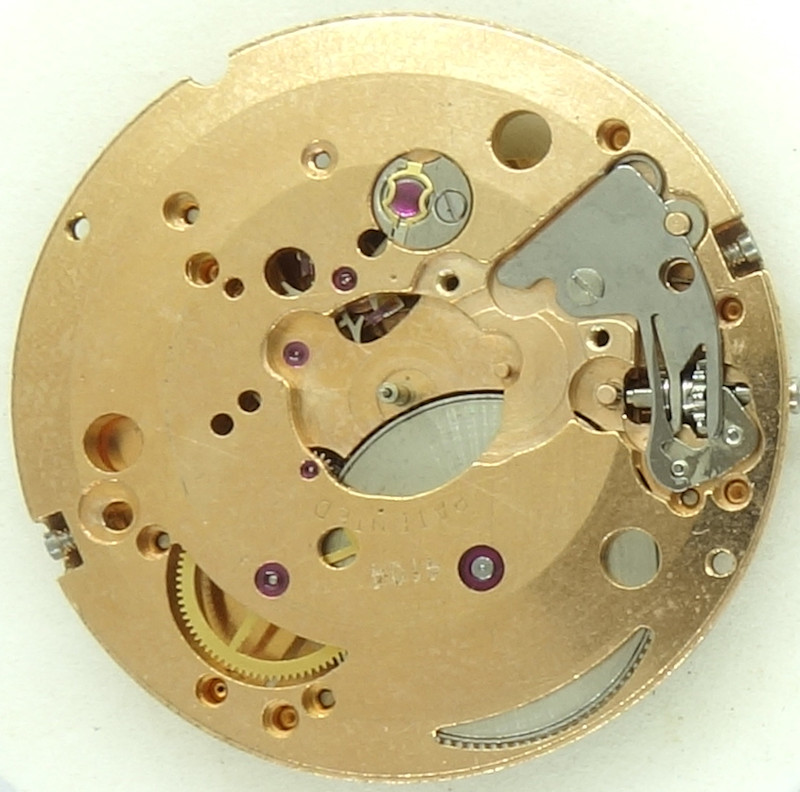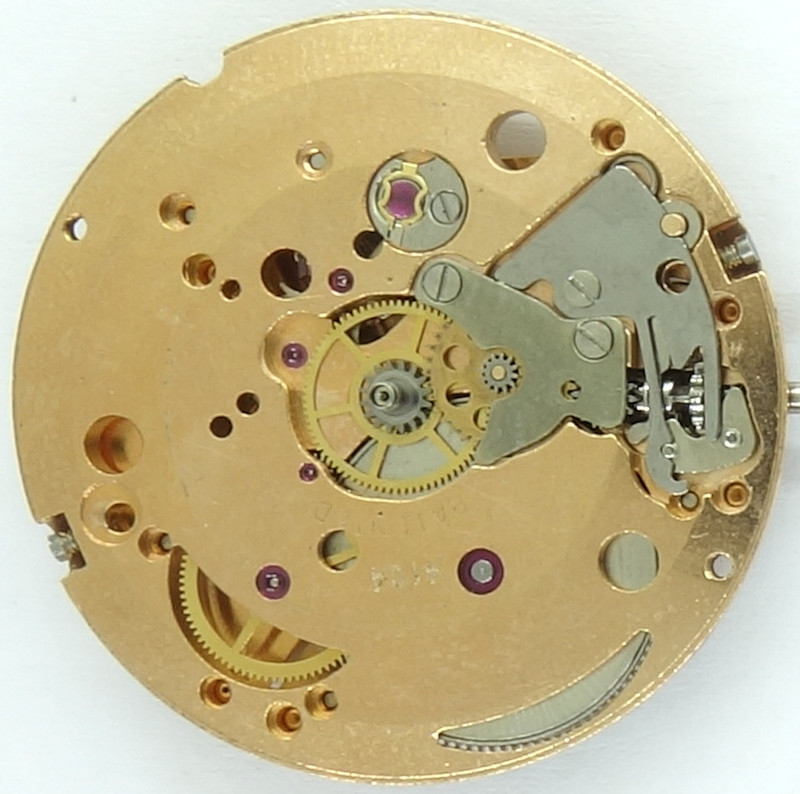Description
In 1963, the swiss ETA launched their first series of high beat selfwinding movement with a beat rate of 21600 A/h = 3 Hz.
The base caliber was the ETA 2620, which had an axle beared oscillating weight. The version with the “R” suffix, the ETA 2620R however, had got a ball-beared rotor.
Helvetia also offered this movement and probably improved it (red-golden coloring of the movement, Glucydur balance) and called it “Helvetia 870”. And since that is not enough, the german Dugena also used this movement for their “Precision” line of watches and called it “Dugena 1076”.
The red-golden toned base plate offers a very beautiful contrast to the dark-red glowing rubies of the bearings, which were used for all bearings (except the long center seconds wheel bearing), even for that of the mainspring barrel.
The contemporarily very modern gear train is used by ETA until today in their movements: Mainspring barrel, second wheel, third wheel, directly driven center seconds wheel and finally the escape wheel.
This gear train allows very large mainspring barrels and balance wheels, which can reach almost to the center of the movement.
The hands are driven on the dial side by the pinion of the third wheel.
Helvetia put a golden toned three-leg screw-less Glucydur balance into the movement. Today, you would call that “High End”, but at that time, it was upper standard.
Of course, the balance wheel is shock protected in two Incabloc bearings.
The hairspring is, very modern for that time, mounted to a moveable stud and its effective length can be adjusted with a long regulator arm. How efficient that system is, even without swan-neck regulator or excenter adjustor, can be seen on the fantastic timegrapher rates below.
It’s common for ETA, that the selfwinding mechanism is executed as a module, which is mounted with two screws onto the movement.
An interesting detail is the square of the barrel arbor: It has got a slanted form at its four edges and should offer a better fixation for a thin ratchet wheel. Details can be read in the patent .
As usual, the selfwinding mechanism consists of two pawl changers, which are engaged to each other by their lower gears, while the upper gears are driven by the oscillating weight.
Afther those two whees, there are two reduction wheels, before the ratchet wheel is driven. Ratchet wheel and crown wheel have a much different toothing , described in patent CH362367A .
The disadvantage of the ETA selfwinding system is, that the automatic gears are not detatched on manual wind, which means, that both pawl changer wheel turn with very high speed.
It’s interesting to see, that the early ETA selfwinding movements have pawl wheels with hollow drives, mounted on very massive axles of the selfwinding plate. Run-in pinions like on modern ETA movements don’t exist there.
The ratchet on the ETA selfwinding movements is always on the crown wheel and never on the ratchet wheel. The earlier ETA movements have got a very well made ratchet pawl, later movement only have cheap springs.
The crown wheel is - typical for ETA - flyingly beared, so that the rotor winding disengages the crown wheel and the winding stem.
The different decorations on that red-golden toned movement are really beautiful!
The ball beared rotor was among the best you could get at that time.
At 8 o’clock, you see the third wheel pinion, which drives the hands. This “System ETA” was patented and should because of the large size and this finer toothing of the minute wheel reduce it’s play and the play of the minute hand.
The minute wheel has got a slipping clutch for the cannon pinion, which carries the minute hand the drives the changing wheel at 3 o’clock. For that minute wheel there exists also a Patent .
Of course, this movement has got a yoke winding system. Its setting lever is mounted with a screw and not, like on later movement, only spring secured and prone against to deep pressings.
Conclusion
A little personal resume at the end: Rarely, an ETA movement made me so excited like the ETA 2620R. Everything on this movement is perfect and shows, how in the early 1960s, it was possible to draw from the full. This makes it even more sad, to see, how much was economized on its successors.
In the lab
It for a simple service and was adjusted.
Timegrapher result
You hardly can do better. All rates are within the chronometer specification, which allows daily deviations from -4 to +6 seconds. Almost unbelievable, when you take into account, that this movement is almost 60 years old and never was an official chronometer!| horizontal positions | |||
|---|---|---|---|
| dial up | +1 s/d | 281° | 0,0ms |
| dial down | +3 s/d | 282° | 0,0ms |
| vertical positions | |||
| crown right (12 up) | +6 s/d | 260° | 0,1ms |
| crown up (3 up) | -2 s/d | 259° | 0,3ms |
| crown left (6 up) | -3 s/d | 254° | 0,3ms |
| crown down (9 up) | +5 s/d | 252° | 0,1ms |
Technical data
| Manufacturer: | ETA |
| Caliber: | 2620R |
| Caliber base: | ETA 2620 |
| Size: | 11 1/2''' (measured: 25,6mm) |
| Height: | 4,60mm |
| A/h: | 21600 |
| lift angle: | 52° |
| Number of jewels: | 25 |
| Escapement: | Pallet lever |
| Balance types: | Glucydur anular balance (three legs) |
| Shock protection(s): | Incabloc |
| Balance bearing / direction hairspring: | Counterclockwise |
| Moveable stud: | yes |
| Adjust mechanism: | Long regulator arm |
| Construction: |
|
| Construction type: | solid construction |
| Winding mechanism: | yoke winding system |
| Setting lever spring: | 2 holes |
| Features: |
|
| References: | Flume: K3 196 |
| Data sheet: | 1968 |
| Inventory number: | 21034 |
